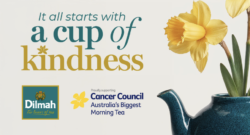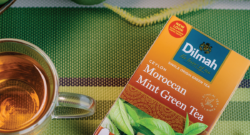Author: Shehani
Can a Cuppa Contribute Towards a Healthy Heart?
“Cardiovascular diseases (CVDs) are the leading cause of death globally. An estimated 17.9 million people died from CVDs in 2019, representing 32% of all global deaths. Of these deaths, 85% were due to heart attack and stroke.” – World Health Organization, 2021 These numbers have risen since 2021, with unhealthy eating habits, stress, smoking, and sedentary lifestyles being the prime contributing factors. There is some degree to which age contributes to the incidence of CVD, as arterial (blood vessel) walls lose their flexibility and elasticity over time, thereby restricting the rate and ease at which blood flows through them. However, the factors mentioned previously are all elements that can be monitored and controlled by our own accord. Before we see where tea comes into all of this, let’s take a brief look at the science behind CVD. What is cardiovascular disease? Cardiovascular disease refers to health conditions pertaining to the heart and blood vessels. The heart is responsible for pumping blood out to the body, and blood vessels are responsible for supplying every tissue and organ in the body with blood. This includes the supply and circulation of blood within the heart as well, via coronary arteries. Any blockage within these arteries could result in an interruption of blood flow to a particular part of the heart, resulting in a myocardial infarction, or what we commonly refer to as a ‘heart attack’. Complete blockage of a major coronary artery could potentially be fatal. The occurrence of the same process in the brain is known as cerebrovascular disease, or what we commonly refer to as a ‘stroke’. Again, depending on the degree and location of blockage, the outcome could have lifelong consequences or potentially be fatal. What causes CVD and stroke? These types of CVDs develop over time, with a gradual deposition of fat, cholesterol or other substances on the inner arterial wall. This phenomenon, known as atherosclerosis, leads to plaque formation that eventually narrows the blood vessel, restricting blood flow through it. There are several factors to which this plaque formation could be attributed, including: These factors, therefore, inadvertently become risk factors for the incidence of CVD / heart attacks and strokes. So, where does tea come into all of this? Let’s look into each aspect. How can tea help to lower blood cholesterol levels? Cholesterol and lipids bind onto proteins, forming lipoproteins, for circulation in the bloodstream. High density lipoproteins (HDL) carry cholesterol and lipids from the bloodstream to organs, while low density lipoproteins (LDL) carry cholesterol and lipids from organs into the bloodstream. Since elevated blood cholesterol and lipid levels increase the risk of CVD and stroke, we casually refer to HDL as ‘good cholesterol’ and LDL as ‘bad cholesterol’. Research shows that tea consumption is associated with a reduction in LDL levels, thereby reducing the absorption of cholesterol and lipids from the food we consume into the bloodstream, and subsequently reducing the risk of CVD and stroke. How can tea help to regulate blood pressure? The endothelium (inner wall of blood vessels) plays a role in regulating blood pressure as it modulates the constriction (narrowing) and dilation (widening) of blood vessels. Dysfunction of this layer, with age or otherwise, could result in an increase in blood pressure, which then becomes a predisposition to CVD and stroke. Tea is rich in flavonoids, which have been shown to improve endothelial function, which would help to maintain healthy blood pressure, and subsequently lower the risk of developing CVD and stroke. How can tea help to lower blood sugar levels? Elevated blood glucose levels can, over time, cause damage to different organs including the heart and blood vessels, thereby increasing the risk of CVD and stroke. While Type 1 diabetes has a genetic predisposition, Type 2 diabetes is generally caused by inefficient insulin function or excessive absorption of glucose from the digestive tract into the bloodstream. Studies show that tea consumption can improve the effectiveness of insulin, while also reducing or regulating the absorption of glucose into the bloodstream. This thereby reduces the risk of developing Type 2 diabetes, subsequently lowering the risk of CVD and stroke. How can tea help to reduce blood clotting? Platelet cells are involved in the blood clotting process in our body. The unwarranted formation and circulation of blood clots can lead to blockage of arteries and increase the risk of CVD and stroke. Tea has been found to reduce this risk by interfering with the clotting process of platelets, thereby lowering the potential for CVD and stroke. How can tea help to reduce oxidative stress? Oxidative stress – high levels of reactive oxygen species (ROS) and free radicals (FR) in the bloodstream – can increase plaque formation in arteries, which can lead to CVD and stroke. Tea is rich in antioxidants, which neutralise ROS and FR, thereby reducing oxidative stress and subsequently lowering the risk of CVD and stroke. How can tea help to reduce inflammation? While inflammation is an essential immunological process, chronic inflammation can lead to an increase in oxidative stress and contribute towards plaque formation in arteries. These, in turn, could cause CVD and stroke. Polyphenols in tea have been found to have anti-inflammatory properties, thereby countering the potential effects of inflammation and subsequently lowering the risk of CVD and stroke. Considering the trove of scientific information that we have tried to summarise here, we can say with a large degree of certainty that the consumption of tea can help to lower the risk of incidence of CVD and stroke. You can learn more about the health benefits related to tea drinking in Prof. Tissa Amarakoon’s comprehensive compilation – Tea and Your Health.
Rosehip & Hibiscus – a Luscious, Healthy Brew
Dilmah’s Rosehip & Hibiscus Natural Infusion has quite the demand among consumers. Not only is it a popular choice of purchase in its original form, but it is also enjoyed in the form of various beverages by visitors to our t-Lounges around the world. Uplifting aroma and sweet-tangy fruity flavour aside, there are several health benefits associated with both rosehip and hibiscus that may also be contributory factors to the popularity of this brew. Rosehip Rosehip is the small but potent fruit of wild rose plants (Rosa canina). They are orange-red, bulbous fruits that develop after the petals of the flowers have fallen. They are native to Europe, Asia and North Africa, and have been used for generations in traditional medicine by indigenous people around the world. The rosehip fruit is rich in vitamins (principally vitamin C), antioxidants and other minerals. Possible health benefits linked to rosehip include: Hibiscus Hibiscus (Hibiscus sabdariffa), also commonly referred to as roselle, is a tropical flowering plant, whose flower’s fleshy red calyx is the main constituent in hibiscus tea. Hibiscus, too, has been used in traditional medicine for centuries, and is a popular ingredient in Western Africa, the Caribbean, and Central and South America. While it does contain trace amounts of minerals such as calcium, magnesium, potassium and phosphorus, what is more significant is its high content of antioxidants – principally polyphenols. Health benefits linked to hibiscus include: Dilmah Rosehip & Hibiscus Natural Infusion Considering all of these characteristics pertaining to rosehip and hibiscus, there is certainly more reason than solely enjoyment to dive into a steaming cup or chilled mug of Dilmah Rosehip & Hibiscus Natural Infusion! If you’d like to get your hands on some, the infusion is available for purchase in both loose leaf and tea bag form. For those of you living in and around Colombo, you can enjoy the innovative Dilmah Rosehip & Hibiscus Natural Infusion-inspired beverages at any of our t-Lounge by Dilmah outlets, which offer the infusion for purchase as well. There might also be some of you who enjoy the occasional culinary adventure… If so, Tea Inspired has a few intriguing ideas that incorporate this luscious natural infusion into unique food and beverage recipes. Rosehip and Hibiscus Macaron, Rosehip and Hibiscus-infused Raspberry Chocolate Swiss Roll, Rosehip and Hibiscus Sorbet, Honey Hibiscus Garden Mocktail, Vodka Rosehip Double t-Shot, and Rosehip and Hibiscus with Pink Ginger Beer t-Mocktail are just a few that you could try your hand at. Do Try It!
Finding Kith and Kin in a Foreign Land
This image may not be all that impressive. However, the context of it certainly is. Most of you might be familiar with the feeling of excitement and sense of pride that comes with seeing a product from your homeland in another part of the world. Particularly somewhere you least expect to find it. It’s like finding kith and kin in a foreign land. So, picture this. You’re a Sri Lankan, sitting in one of the most populated resto-cafés in Bled, Slovenia, surrounded by hundreds of tourists, with not a fellow Sri Lankan in sight. So busy is the vast café terrace that you’ve had to wait a fair amount of time to be seated, and have to share the table with a couple of other foreigners. Tourists – in bus loads – are here to visit the iconic Bled Castle and take in the beauty of Lake Bled in its awe-inspiring surroundings, with the Julian Alps casually sitting around in the backdrop. Most of the folk at the café are here to get a taste of the highly-acclaimed Bled Cream Cake (apparently Sava Hotel in Kavarna Park serves the most authentic). You have a penchant for Earl Grey tea, and so order a cup to go with the cake. Someone else orders a green tea with mint. Your order arrives. You definitely didn’t see this coming… There’s a Dilmah Silver Jubilee Gourmet Earl Grey Tea sachet and a Dilmah Vivid Gently Minty Green Tea sachet in front of you – with teacups and saucers that read, ‘Dilmah – The Single Origin Tea’. Imagine the pleasant surprise and humble pride that wells up at seeing such a familiar piece of home, nearly 5,000 miles away from home. It’s like finding kith and kin in a foreign land. Not many of these people knew much about Sri Lanka, but they were enjoying the finest of Ceylon tea. Dilmah Silver Jubilee Gourmet Teas include a stellar array of 11 of Dilmah’s most loved brews, specially created to celebrate 25 years of goodness presented to the world by Dilmah Ceylon Tea. The collection encompasses some of the more classic teas such as Ceylon Original Breakfast, Earl Grey, Pure Darjeeling and Nuwara Eliya Afternoon teas, as well as more vivacious brews such as Ginger, Honey & Mint Black Tea, Mandarin & Marzipan Black Tea, and Blood Orange & Eucalyptus Infusion. You can browse through the entire Silver Jubilee Gourmet repertoire here. Dilmah Vivid is another gourmet collection of teas which, as the name suggests, has been created to bring a touch of vibrancy to the table – and a burst of colour onto your palate. Each of the teas aims to create a personal connection with the drinker through its unique characteristics. The Gently Minty Green Tea that was served in Bled was a beautiful mix of calming steamed sencha green tea, pepped up with spearmint and a touch of lemongrass. Equally intriguing are Springtime Oolong with Ginger, Ceylon Tea with Pomegranate & Mint, Ceylon Tea with Chocolate & Mint, and the Natural Lemon Verbena Infusion. You can have a look through the entire assortment of Vivid teas here. Have you had a similar experience, coming across our beloved Dilmah Ceylon Tea in a place that you least expected? If so, we’d love to hear about it. Do share your story with us in the comments or on socials.
A Cuppa from Ceylon Above the Clouds
There are partnerships, and then there are partnerships. The bond between Emirates Airline and Dilmah Ceylon Tea is one such partnership that took off over three decades ago. Having served their first cup of Dilmah back in 1992, the multi-award-winning airline continues to serve a selection of twelve Dilmah favourites to their passengers, 33 years later – a time span that minnows even the iconic A380 aircraft’s mammoth wing span! With an average of 33 million cups of Dilmah tea being poured out across Emirates’ cabins and lounges in a year, it is beyond apparent that this partnership is built on a strong foundation of trust and understanding. Both Dilmah and Emirates are internationally appreciated brands that are determined to leave their consumers with a lingering taste of satisfaction. The mutual recognition and respect for each other’s shared values has enabled the establishment of a partnership that has overcome challenging phases over the years, including economic recessions and the recent COVID-19 pandemic which brought global travel to a standstill. From Emirates Group Head Quarters in Dubai, UAE to the Dilmah Tea Head Office in Peliyagoda, Sri Lanka, there is much admiration between the two companies for their shared philosophies. Product/service quality is of paramount importance to both, with Emirates determined to give its passengers a ‘Fly Better’ experience, and Dilmah – in late Founder Merrill J. Fernando’s words – set to ‘Make the World a Better Tea’. Likewise, both brands are heavily involved in giving back to the community, too, through the Emirates Airline Foundation and the MJF Charitable Foundation, respectively. It seems only fitting, therefore, that Dilmah has created a unique Emirates Signature Tea that culminates a long-standing bond between the two entities. The exclusive tea is served to the airline’s First Class passengers, and is a combination of Dombagastalawa Estate Ceylon FBOP1 tea with safflower and marigold flowers, scented with rose, ginger and almond. Whether you’re looking to wind down and catch up on some rest, or to reawaken your senses after a nap, the incredible aromatic combination is capable of both rejuvenation and relaxation. It is best enjoyed without milk or sugar, although it does pair well with the little sweet treats that Emirates’ hospitable crew might offer. This year (2025), in celebration of International Tea Day on 21st May, passengers travelling across all cabins on Emirates flights over 2.5 hours received a gift pack of three Dilmah Teas – Emirates Signature Tea, Moroccan Mint Green Tea and Black Tea with Strawberry. First and Business Class customers were also treated to specially-crafted Dilmah Tea-inspired mocktails and cocktails at Emirates Lounges internationally. It was a celebration not just of the finest tea in the world, but also of a fine partnership that has taken quality Ceylon tea and in-flight hospitality across borders, to newer and greater heights – literally and metaphorically. So, here’s raising a cuppa to a perfectly-brewed partnership between Emirates Airline and Dilmah Ceylon Tea, for many more decades to come!
A Cup of Kindness for Australia’s Biggest Morning Tea
Dilmah is no stranger to sharing kindness for a worthy cause, particularly in relation to cancer care and treatment. At home in Sri Lanka, Dilmah has a close, long-standing association with Suwa Arana, the first-ever paediatric palliative care facility in Sri Lanka. As you might have seen in previous blog posts, Dilmah is also a supporter of the Government’s programme, in conjunction with the Rotary Club of Colombo, to work towards eradicating cervical cancer from Sri Lanka by the year 2030. So, it was only natural for Dilmah to share this cup of kindness beyond Sri Lankan shores and try to help those affected by cancer in Australia as well. For the past 32 years, Cancer Council Australia has raised over AUD 200 million through its iconic Australia’s Biggest Morning Tea (ABMT) community fundraiser programme. Over half-a-million Australians have partaken in this, by hosting and organising morning teas to raise funds for cancer research, detection, prevention, care and support. Considering that 1 in 2 Australians is affected by cancer in some way or form, the impact of ABMT is not only life-saving for patients, but also life-changing for their families. As of July 2025, Dilmah has joined hands with Cancer Council Australia in a five-year partnership to support ABMT. Dilmah Chairman Dilhan C. Fernando shared his thoughts on this, stating, “Our partnership with Cancer Council highlights Dilmah’s commitment to Australians impacted by cancer. Forty years ago, my father envisaged a business that serves humanity with kindness to people and nature. Today we strive to offer cups of kindness through our Dilmah tea.” In brewing this ‘cup of kindness’, the partnership directly reflects the philosophy of our late Founder Merrill J. Fernando that ‘business is a matter of human service’. It is also, in a sense, a token of appreciation to Dilmah’s Australian family – its consumers who embraced the brand since it was first introduced to the country in 1985. In fact, Australia was the first international market that enjoyed MJF’s beloved Single Origin Dilmah Ceylon Tea. For those impacted by cancer, every minute counts. For those doing research into cancer, every dollar counts. That is why we, at Dilmah, are determined to make every cuppa count. If you’re reading this from Australia (or have family and friends in Australia), visit https://www.biggestmorningtea.com.au/ to find out how you can support our collaborative effort in the fight against cancer.
POV: Moroccan Mint Green Tea in Your Drink
It’s rare to come across someone who doesn’t enjoy Moroccan Mint Green Tea – which is why we thought of sharing a few tea-inspired beverage recipes that use Dilmah Pure Ceylon Green Tea with Moroccan Mint as their base. There are countless ways in which to incorporate this refreshing tea into cocktails, mocktails, shakes, and so much more. Here are four recipes that we hope will add a bit of versatility and new perspective on how you can enjoy your Dilmah Moroccan Mint Green Tea. Do give them a shot, and share your experience with us in the comments. RECIPE 1: Cucumber and Moroccan Mint Ice Cubes (tea-inspired ice cubes) Use these sassy ice cubes to pep up any chilled tea, infusion or mild beverage of your choice. We think they’re a fabulous idea when hosting, too. What you need: How to prepare: RECIPE 2: Minty Turmeric Tea (tea-inspired immunity booster) Flu season seems to last all-year-round in this post-COVID era! It’s always a good idea to give your immunity a natural boost every now and then. Here’s something that could work well. What you need: How to prepare: RECIPE 3: Coconut Green Tea (tea-inspired tropical mocktail) Here’s a tropical temptation that we think would cool anyone down on a warm summer day. What you need: How to prepare: RECIPE 4: Moroccan Mint Tea Latte(tea-inspired gourmet mocktail) This one’s for those of you who like to be a little more adventurous in the kitchen – or rather, at the counter. What you need: How to prepare: There are plenty more Dilmah Moroccan Mint Green Tea and other tea-inspired recipes of varying complexity for you to try out at teasinspired.com. Dilmah Moroccan Mint Green Tea is available for purchase at Dilmah Tea Boutiques, t-Lounge by Dilmah outlets and at our online shop.
Jono and Ben Raise a (Golden) Cuppa to Sri Lanka
Jono and Ben are no strangers to radio and television audiences in New Zealand. Having been in the entertainment industry since 2012, the duo is known for their witty humour, and currently co-host The Hits Breakfast show on iHeart radio in New Zealand. Dilmah Ceylon Tea is no stranger to New Zealand households, either, with Dilmah teas and infusions being a favourite among Kiwi tea drinkers. So, it was the perfect collaboration between Jono and Ben, and Dilmah to endorse our beautiful little island as a must-visit destination for New Zealanders. Dilmah Chairman Dilhan C. Fernando and his son Amrit, the third generation in the family business, took great pleasure in keeping their two guests company and showing them how the legacy of their father/grandfather continue to live on through the brand. A glance through Jono and Ben’s Instagram reels gives an idea of how much they enjoyed Sri Lanka, and the many activities and attractions that the island has to offer. Of course, having Dilmah as their host only amped up the experience. The lads were given behind-the-scenes access to Dilmah Head Office operations, guided tours of Dilmah’s Dunkeld Tea Factory and luscious tea gardens (including a crash course in tea plucking!), and the opportunity to experience the warmth of Sri Lankan hospitality at our spectacular Ceylon Tea Trails planters’ bungalows. From luxury in the hills to glamping at the edge of jungle-meets-beach, Jono and Ben were also treated to a stay at Wild Coast Tented Lodge in Yala, where they came face-to-face with local wildlife at breathtakingly-close proximity – both on site as well as on safari at Yala National Park. The contrast between locations of the boutique properties in the hills and in Yala – all of which are owned and run by Resplendent Ceylon, MJF Group’s luxury hospitality arm – is a reflection of the versatility that Sri Lanka can offer within a few hours’ road travel. Jono and Ben also got to experience first-hand how Dilmah continues to imbue our beloved late Founder Merrill J. Fernando’s philosophy of “business is a matter of human service” through the MJF Charitable Foundation’s programmes for marginalised women, children, youth and communities. A visit to Dilmah Conservation’s Elephant Transit Home at Udawalawe National Park proved to be another eye-opener as the duo got to witness how Dilmah contributes towards the well-being and preservation of nature as well. The most exciting aspect of all of this is that five pairs of Dilmah tea drinkers in New Zealand now stand a chance to win a trip to Sri Lanka and share in the same amazing experiences that Jono and Ben did. While at the Dilmah Head Office, the Kiwi lads slipped a couple of Golden Teabag Tickets into two boxes of Dilmah Ceylon Tea that were bound for retail outlets in New Zealand. In addition, Dilmah has put in three further Golden Teabag Tickets in tea packs that were New Zealand-bound. If you’re reading this from Kiwi-land, we strongly suggest that you head over to your nearest supermarket and stock up on some Dilmah Ceylon Tea. Who knows, you could be the next lucky winners to enjoy an all-expenses-paid trip to our serendipitous island! While extending our thanks to Singapore Airlines, Resplendent Ceylon and The Hits Breakfast for their partnership, we would like to wish all our Dilmah friends in New Zealand the best of luck in their quest for the Golden Teabag Tickets! We look forward to welcoming you here in Sri Lanka!
Level One Levels Up at t-Lounge Horton Place
Anyone who’s been to t-Lounge by Dilmah at Horton Place once would almost certainly have made it a point to visit again. It’s homely, they plate up striking, delicious dishes (oh, those desserts!), pour out exquisite tea-inspired beverages, and – in modern-day jargon – it’s the vibe. Just when we thought they couldn’t possibly make it any better, they pushed things up a notch with a complete revamp of the upper floor. The new ‘do is all about charm sophistication and contemporary elegance. Together with the t-Lounge team, the visionary designers at PA Designs have transformed the entire level into a cocoon of laid-back luxury. There is much more to offer to patrons now, with each space and room being relaunched into more functional (and aesthetically enchanting) versions of their previous selves. As you walk in through the corridor atop the staircase, one might momentarily get the feel of walking through a wildlife sanctuary. However, a closer look reveals how the walls on either side have been used as a canvas to depict both significant and trivial aspects of Sri Lankan history, culture, architecture, nature and life. There’s much to observe and appreciate in this work of art, if you have a moment to spare. A seamless sage-matte gold combination forms the basis of the palette across the floor, with a pop of colour injected into the main lounge/dining space by means of the orange-cushioned couches. The dark mahogany tone incorporated through the door panels and furniture add a subtly weighted depth to the space. While the wall art here portrays playing cards with colonial-era characters, the Private Dining room’s art is more contemporary – and quirky even – in keeping with its décor and feel. This spacious enclosure can easily accommodate a party of 6-10 people. A space that is bound to chirp anyone up is the t-Studio Workshop Space / t-Bears Academy Activity Space. t-Lounge at Horton Place is known for hosting creative events such as paint-and-sip sessions for adults, and many fun and interesting activities and workshops for kids. This room, therefore, provides the perfect functional space for both adult and kiddie activities, alike. The tones of blue here soothe like a breath of fresh air, while the colourful pastels of the wallpaper and furniture instantly create the impression of a more fun and creative space. The Tea Maker’s Study co-working space means business with its more toned down, tan hues and boardroom-like furnishings. Of course, a little something off the t-Lounge food and beverage menu is all it would take to break the ice and turn any meeting – no matter how formal – into a fun and productive session. The wall art here is subtle and non-distracting, some of it a nod to our late Founder Merrill J. Fernando, the ‘Tea Maker’ after whom the room gets its name. As per t-Lounge’s socials, an exciting new menu has now been launched, too. If the recent relaunch at Horton Place is anything to go by, the menu makeover will definitely be something to look forward to, dive into and indulge in. All in all, the new vibe at t-Lounge by Dilmah at 100 Horton Place is next level. Do check it out! Contact the t-Lounge crew on 011 2670270 for reservations or to book a cozy space of your own for your next meeting or event. Follow @teatimerocks for the latest updates.








